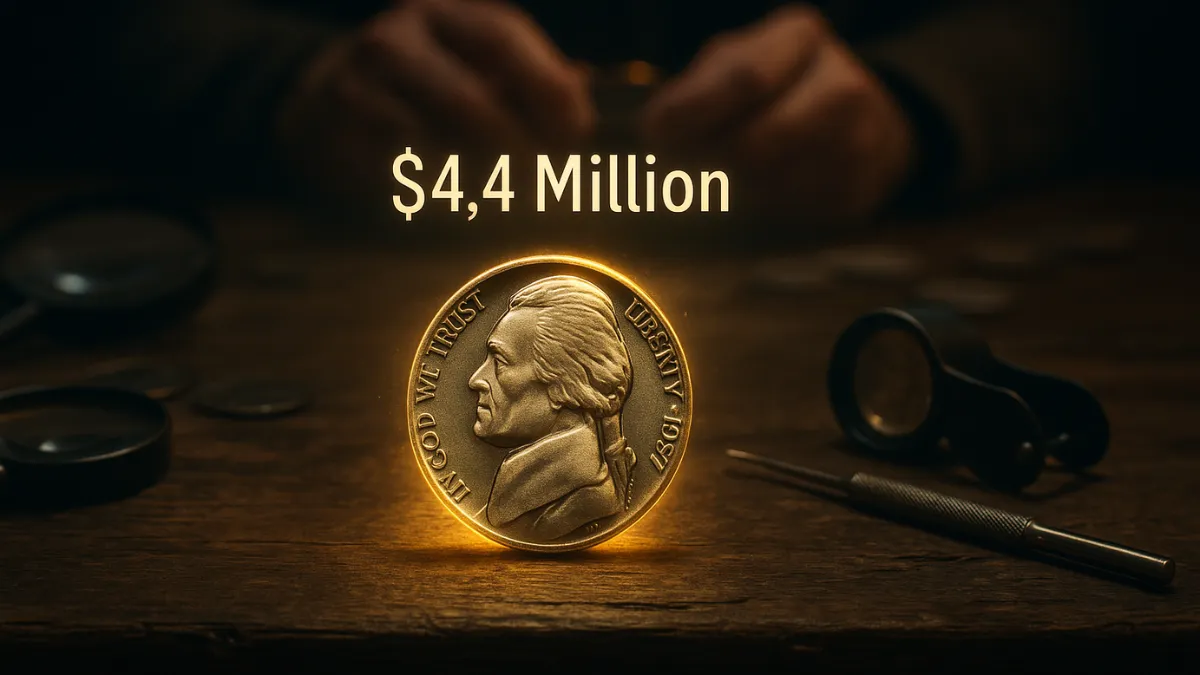There Are Wonders in the World of Coin Collecting
Coin collecting holds many surprises, and some of them may be sitting unnoticed in your loose change. Recently, the coin world has been buzzing about a Jefferson nickel that’s reportedly valued at an astonishing $4.4 million. Yes, a coin you might find in your pocket today could be worth more than a luxury home.
But what gives a simple five-cent piece such a high value? The answer lies in its rarity, its story, and a touch of mystery that captures collectors’ imaginations.
A Quick Look at the Jefferson Nickel
The Jefferson Nickel has been part of U.S. currency since 1938, replacing the iconic Buffalo Nickel. Its front side features President Thomas Jefferson, while the reverse shows Monticello, his famous home. While most Jefferson nickels are only worth their face value, a select few are incredibly rare. One such coin has become the focus of collectors everywhere.
The $4.4 Million Nickel: What Makes It So Valuable?
Experts in numismatics believe the $4.4 million Jefferson Nickel is not an ordinary coin. It likely dates back to the WWII era between 1942 and 1945, a time when the U.S. Mint altered the nickel’s metal content to preserve nickel for the war effort. These special coins, known as “War Nickels,” contained 35% silver, instantly making them more desirable.
However, this particular coin stands out even among war nickels. It’s thought to be a rare error coin, possibly struck during the early transition to the wartime alloy in 1942. This type of minting mistake, especially involving metal composition, is extremely rare and highly prized by collectors.
Its near-perfect or uncirculated condition further increases its appeal. Combining a mint error, historical background, and excellent preservation makes this nickel a true treasure.
Found in Everyday Life?
What’s truly amazing is where this rare nickel was found. Reports suggest it came from a simple family coin jar. Someone unknowingly had this multimillion-dollar piece in their home until a knowledgeable collector identified it.
Though rare, stories like this do happen. Over the years, people have found valuable coins in pockets, coin rolls, and piggy banks. These finds inspire hopeful collectors to keep searching.
How Can You Tell If Your Jefferson Nickel Is Valuable?
Thinking of checking your change? Here are key signs that your Jefferson nickel could be valuable:
- Date and Mint Mark: Watch for rarities like 1939-D, 1950-D, or nickels from wartime years (1942–1945).
- Condition: Coins closer to their original mint state are generally worth more.
- Errors or Variants: Unusual features such as double dies, misprints, or alloy mistakes can raise the value.
- Full Steps: Jefferson nickels with clear “full steps” on the Monticello building are especially desired by collectors.
Even if your nickel doesn’t make you a millionaire, some are still worth far more than five cents.
Collectors Weigh In
Seasoned collectors say this find serves as a wake-up call to everyone to take a second look at their coins. One hobbyist from Denver mentioned that coins like this are proof that pieces of history can hide in plain view. “It’s thrilling to imagine finding treasure at a gas station checkout counter,” they shared.
Final Thoughts
The $4.4 million Jefferson Nickel represents more than monetary value—it’s a piece of American heritage, a collector’s jackpot, and a reminder that even small things can hold great worth. While the chances of finding one are slim, stories like these breathe life into the coin collecting hobby.
So the next time you get change back at a store, pause before you toss that nickel aside. It might just be something extraordinary.
FAQs
Q1. What years should I look for in Jefferson nickels?
Look for rare years like 1939-D, 1950-D, and the wartime dates from 1942 to 1945, which may contain special materials or minting errors.
Q2. How can I tell if my Jefferson nickel has “full steps”?
“Full steps” refer to the clearly visible steps on Monticello on the back of the coin. If the design is sharp and detailed, especially on the steps, it can significantly increase the coin’s value.
Q3. Why are wartime Jefferson nickels more valuable?
Between 1942 and 1945, these nickels were made with 35% silver due to WWII material needs, which makes them more sought after than standard issues.
Q4. Can valuable nickels really be found in everyday change?
Yes, rare coins have been discovered in ordinary coin jars, pockets, and change trays. These discoveries prove that valuable coins can still be in circulation.
Susan is a seasoned finance writer with a knack for breaking down complex money topics into clear, actionable advice. With years of experience in personal finance, investing, and market trends, she empowers readers to make smarter financial decisions. Her work has been featured in leading finance blogs and publications, where she combines sharp analysis with relatable storytelling. Whether it’s budgeting, wealth-building, or decoding the latest economic shifts, Susan’s mission is to help people take control of their financial future with confidence.
